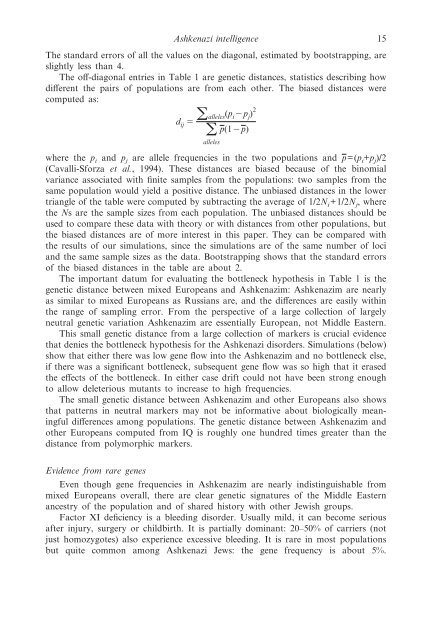natural history of ashkenazi intelligence - Henry C Harpending ...
natural history of ashkenazi intelligence - Henry C Harpending ...
natural history of ashkenazi intelligence - Henry C Harpending ...
You also want an ePaper? Increase the reach of your titles
YUMPU automatically turns print PDFs into web optimized ePapers that Google loves.
Ashkenazi <strong>intelligence</strong> 15<br />
The standard errors <strong>of</strong> all the values on the diagonal, estimated by bootstrapping, are<br />
slightly less than 4.<br />
The <strong>of</strong>f-diagonal entries in Table 1 are genetic distances, statistics describing how<br />
different the pairs <strong>of</strong> populations are from each other. The biased distances were<br />
computed as:<br />
dij � �alleles (pi�pj )2<br />
p(1�p)<br />
�<br />
alleles<br />
where the p i and p j are allele frequencies in the two populations and p=(p i+p j)/2<br />
(Cavalli-Sforza et al., 1994). These distances are biased because <strong>of</strong> the binomial<br />
variance associated with finite samples from the populations: two samples from the<br />
same population would yield a positive distance. The unbiased distances in the lower<br />
triangle <strong>of</strong> the table were computed by subtracting the average <strong>of</strong> 1/2N i+1/2N j, where<br />
the Ns are the sample sizes from each population. The unbiased distances should be<br />
used to compare these data with theory or with distances from other populations, but<br />
the biased distances are <strong>of</strong> more interest in this paper. They can be compared with<br />
the results <strong>of</strong> our simulations, since the simulations are <strong>of</strong> the same number <strong>of</strong> loci<br />
and the same sample sizes as the data. Bootstrapping shows that the standard errors<br />
<strong>of</strong> the biased distances in the table are about 2.<br />
The important datum for evaluating the bottleneck hypothesis in Table 1 is the<br />
genetic distance between mixed Europeans and Ashkenazim: Ashkenazim are nearly<br />
as similar to mixed Europeans as Russians are, and the differences are easily within<br />
the range <strong>of</strong> sampling error. From the perspective <strong>of</strong> a large collection <strong>of</strong> largely<br />
neutral genetic variation Ashkenazim are essentially European, not Middle Eastern.<br />
This small genetic distance from a large collection <strong>of</strong> markers is crucial evidence<br />
that denies the bottleneck hypothesis for the Ashkenazi disorders. Simulations (below)<br />
show that either there was low gene flow into the Ashkenazim and no bottleneck else,<br />
if there was a significant bottleneck, subsequent gene flow was so high that it erased<br />
the effects <strong>of</strong> the bottleneck. In either case drift could not have been strong enough<br />
to allow deleterious mutants to increase to high frequencies.<br />
The small genetic distance between Ashkenazim and other Europeans also shows<br />
that patterns in neutral markers may not be informative about biologically meaningful<br />
differences among populations. The genetic distance between Ashkenazim and<br />
other Europeans computed from IQ is roughly one hundred times greater than the<br />
distance from polymorphic markers.<br />
Evidence from rare genes<br />
Even though gene frequencies in Ashkenazim are nearly indistinguishable from<br />
mixed Europeans overall, there are clear genetic signatures <strong>of</strong> the Middle Eastern<br />
ancestry <strong>of</strong> the population and <strong>of</strong> shared <strong>history</strong> with other Jewish groups.<br />
Factor XI deficiency is a bleeding disorder. Usually mild, it can become serious<br />
after injury, surgery or childbirth. It is partially dominant: 20–50% <strong>of</strong> carriers (not<br />
just homozygotes) also experience excessive bleeding. It is rare in most populations<br />
but quite common among Ashkenazi Jews: the gene frequency is about 5%.


